I can remember my mother mending piles of clothes. She mended the mends, and she even darned the hose and socks. I recall her using a shot glass and a hooked tool to mend her hose. WOW, she worked a job, kept up the house, including repairing the shingles on the roof, and still had time for mending.
I don't mend very much these days. My kids are grown and occasionally bring me mending. . . I work hard at not mending, it is a difficult job dodging the patches, but someone has to do it.
These days, if I want to save a garment, I look over all my embroidery designs for just the right one to use as a rescue design. I have become sort of a champion of resurrecting a damaged garment. It is actually an art which I think is creative and innovative, not to mention reuseful (is that a word?).
There are a few things about using a design in this manner that you need to consider before you actually put needle to fabric. These are my personal observations, you may find other issues, and some that will make this salvage unworkable. I would like to hear your comments and ideas on what you may have done or think you are going to try. As with all embroidery issues and possible solutions, there is always more than one way to handle it.
The initial consideration for this task is to discover if the design will work for your project. Let's say that your repair is on the knee of a pair of denim jeans. Some of those tears can be very large. I have seen them big enough to put a Mack Truck through! So, we have to decide if our designs are large enough to cover the offending area.
Just as you would for any project, do a ‘discovery' test (aka sewout) to be sure you have the right results. The center, edges and total coverage need to be verified and, of course, the other items you will find during that discovery.
The next aspect you will be facing is the fact that you may be working on a boy's wreckage. Designers are not known for items for little boys and the older they get, the harder it is to find something workable. I found this one here at AnnTheGran and thought it would be a great patch for a medium sized knee patch. The basketball is almost 4" by 4" and beautifully done in 6 colors. Adding that many colors really does make a design more lively, and this group, "Sports Bugs I" is really a great pack to have on hand. (I would use the second design on totes for a boy's backpack.)


Trapunto would be a great subject for this kind of repair. I would use a patch, larger than the opening, for the base. This Starbird trapunto is a great one:

You can do a lot of things for a girl's jean or clothing, those options are nearly endless.
The next thing you will be thinking about is where the rip/stain (stains are a problem too!) is located. I promise that the problem area will not be centered, on the exact pocket or anywhere that is logical. It is going to be - under the arm, next to the sleeve, on top of a really thick seam or another place that does not make sense to embroider.
It is time to think out of the box, circle, triangle or other place where people get stuck when it comes to that offending place. If you must, you may have to take apart a portion of the garment, like those wicked seams on jeans. Embroidery does not play nicely with those seams. I have taken apart that seam, the minimum I can get away with, and flattened that portion of the fabric.
If placement is really weird, embroidery may not make sense for the repair. However, if that repair is that unmanageable, any repair will be a problem.
The last, and probably most unusual issue for the repair will be the stabilizer to use. If you are doing denim, you need to be sure to use a heavy cutaway. Cutaway stabilizers are the toughest available, and holding together a rough fabric that will not be treated with "kid gloves."
This hole was really a small one and it was on a denim skirt. It was an easy one to handle.
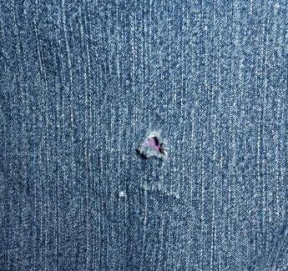
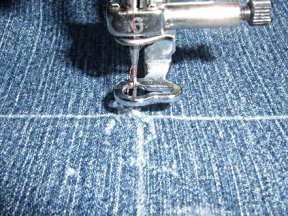
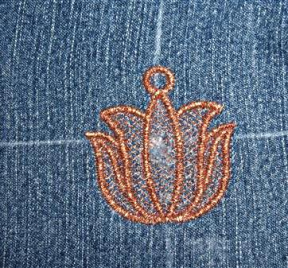
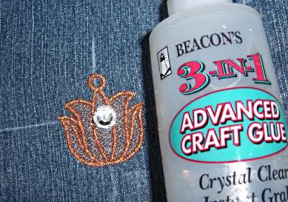
I have done this floral FSL many times and since the size was perfect, I felt it would be right for this hole. As you can see in the 3rd photo, some of the fuzz of the hole comes through. Since it was so small, I just placed a little bling on it. I use the glue in the photo because it does an (almost) immediate grab which is a very nice feature for FSL, especially the 3D FSL.
BTW, don't forget about worn and frayed collars and cuffs. They can be embellished as well. I would do them with FSL. The "Adorable Ideas Vintage Lace" collections are authentic freestanding Schiffli Lace designs that were created by the Adorable Ideas family over 4 decades ago. These are sold for only $3.95 ($3.36 if you are an AnnTheGran Club Member).
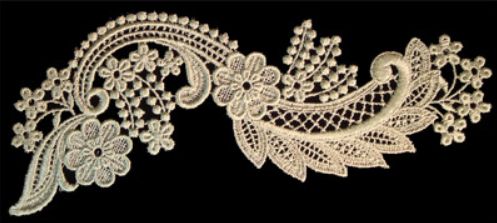
If I wanted to do this as a ‘frilly' lace, I might have a 9" edge, but create an FSL about 15 to 18". I would create a ‘gather' of the FSL and attach it to the edge with invisible thread - when I can find it --- LOL!
An alternative method I have used is to get the ‘iron on' patches available at any fabric store. I use contrasting patches and coordinating ones as well. Then I put a simple design on it that suits the person and garment I will be restoring. I know that ‘iron on' methods can fail, so I will do a zigzag or frame from my embroidery machine around the finished patch.
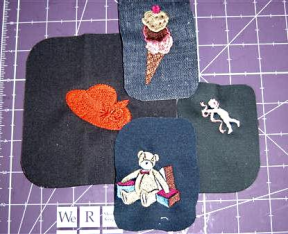
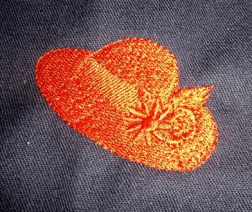
The hat is a design on my machine and is done in 5 colors, I like it done in a single color.
Since there was much discussion about denim, I do want to point one more thing out. It is difficult to make a color contrast with denim. It is such a neutral color that most colors blend in with use. I used a copper colored metallic thread on my skirt repair, and while it is a good contrast in person, it does not make much of a statement in the photo. That just might just be the reason that jeans get embellished with lots of stitching and gems, to get a big bang look.
I hope you got an idea or two from this blog. Do add any information you consider germane to this information. We all love to learn from each other. I am certain every one of you have something to contribute!
Pat